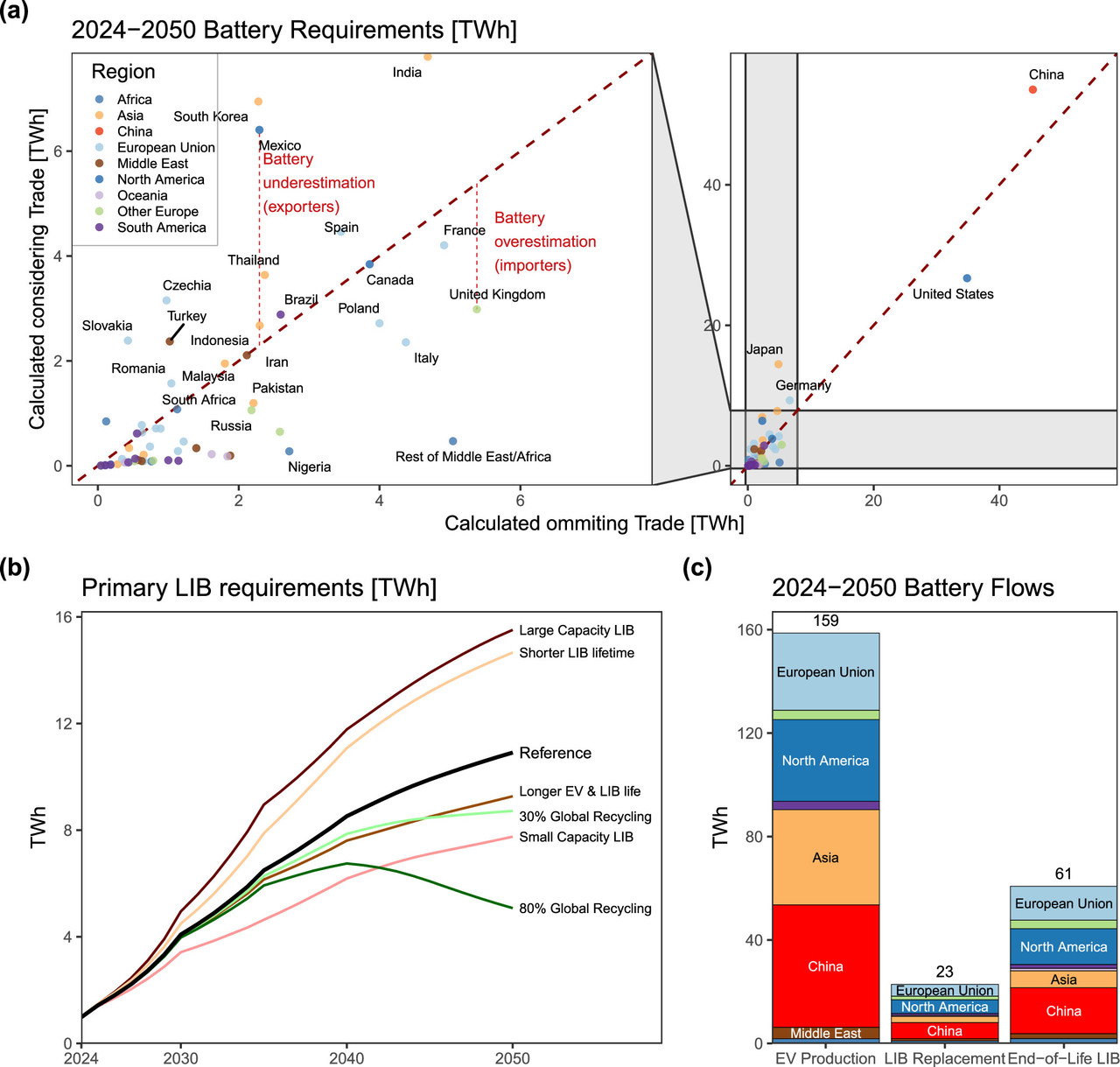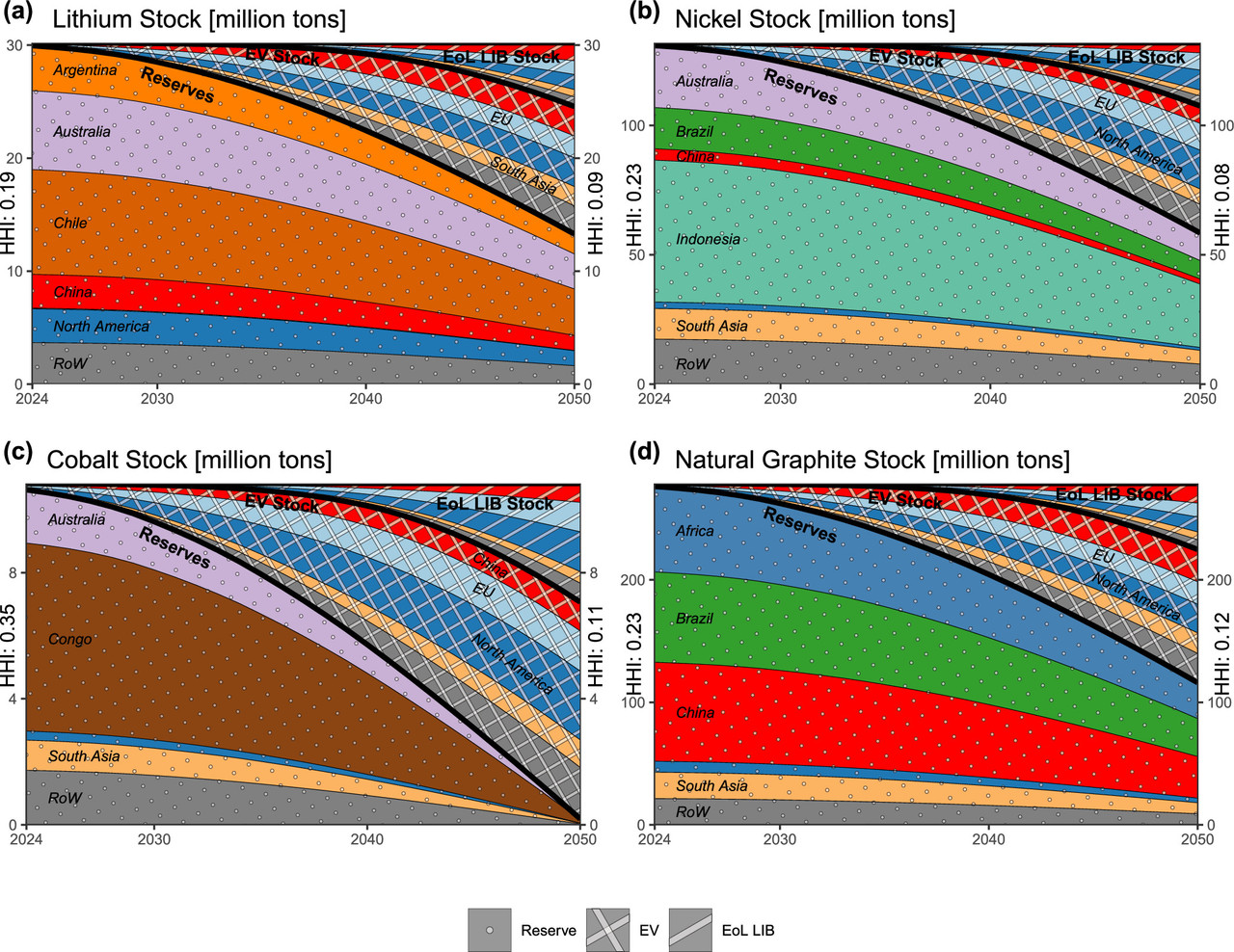Environment & Energy
Related: About this forumWho Will Have Enough? Battery Mineral Demand and Sufficiency in Vehicle Producing Countries.
The paper I'll briefly discuss in this post is this one: Who Will Have Enough? Battery Mineral Demand and Sufficiency in Vehicle Producing Countries Pablo Busch, Francisco Pares, Gil Tal, and Alissa Kendall Environmental Science & Technology 2025 59 (45), 24392-24403.
It remains a common perception that electric cars are "green," although there is absolutely no evidence, after years and years and years of "green car" rhetoric that this is the case. There are no such things as "green cars" because there are no avenues, I insist, to making the car CULTure sustainable.
The perception is based on the delusional yet widely believed concept that so called the trillion dollar so called "renewable energy" industry is somehow a workable alternative to fossil fuels and that it is a major source of electricity. This is also nonsense. Wind and solar remain, after decade upon decade of hype, mostly put forth by antinukes who couldn't give a shit about fossil fuels, trivial sources of energy. The rise in popularity of the reactionary impulse to make energy supplies dependent on (increasingly destabilized) weather, has only led to acceleration of the collapse of the climate from dangerous fossil fuel waste, chiefly, but not limited to, carbon dioxide.
I used to say that "Experiment tr***s theory," using the card game word for "supersedes" that has been transformed into an unspeakable obscenity because of the orange pedophile in the White House. The results of the disastrous experiment of trying to support human well being (and ecological well being) with wind and solar energy coupled with energy storage through batteries, or worse, hydrogen are in. The land and material requirements of the reactionary scheme are unsustainable.
The paper cited at the outset, is about the latter, material requirements, for the storage medium batteries. It's about cars, but it extends obviously to storing so called "renewable energy," not that there has ever been enough so called "renewable energy" to justify the expensive redundancy.
From the introductory text:
While the high energy density of LIBs is a key performance need for their use in EVs, they require lithium (Li), nickel (Ni), cobalt (Co) and graphite, among other energy transition minerals (ETMs). (5) ETM designation is a function of their importance for clean energy technologies, the lack of viable substitutes, and their risk of supply disruption. (6,7) An increase in demand for EVs requires mining of these minerals from geologic resources, which entails a geopolitical risk as the main reserves (the fraction of resources that are currently economically feasible to extract) tend to be concentrated in few countries. Besides the geopolitical risk, mining for minerals generates environmental, health and social impacts, which could translate into opposition by local communities. (8)
New automotive supply chains are being developed for the EV transition, including mineral extraction, processing, cathode and battery manufacturing, vehicle assembly and end-of-life (EoL) management systems. In the context of these new supply chains, countries that have reliable access to ETMs, either via domestic reserves or trade relationships with countries abundant in ETMs, (9) have a competitive advantage in future EV production. The recovery of ETMs from EoL LIBs provides a strategic opportunity for industrial development in countries that do not produce vehicles but import them (new or used); however, they will need to develop the capacity to collect, process, and recover ETMs from LIBs.
Multiple studies have forecasted mineral demand for EVs, LIBs and ETMs. (5,10−22) When supply analysis is included, it usually just compares cumulative demand against reserves at global scales, (23) without considering the geographic concentration of reserves and the location of demand. For example, most studies calculate ETM requirements based on the country where EVs are sold, (24−26) rather than where they are produced, despite that LIBs are required at the manufacturing location. (27,28) Similarly, material flow analysis (MFA) studies for ETMs have been conducted at global levels aggregated by regions, (12,21) or focused on only one region like the United States (US), (19) Europe, (24,29,30) or China; (31,32) or omitting the rest of the world... (26)
I have bolded the common terms that are produced by rote without a shred of experimental, environmental, technological or economic (technoeconomic) support by experiment.
Some graphics from the text:

The caption:

The caption:

The caption:

The caption:
With respect to figure 4's caption, the word I have bolded should give pause to anyone thinking that batteries are involved with something "renewable." My experience teaches me otherwise, but as a tee shirt the AAAS sent me with my membership that I love to wear says, "Facts Matter."
There is a fifth graphic, involved with assuming the case of 95% recycling of battery materials. Recycling anything, particularly a scale of millions of tons, takes besides logistics, energy. The problem for all cases of recycling is that, energy, and claiming that there will be energy to address the recycling of requisite energy materials can be circular, in the logical sense, not the material sense, which, in the latter case, is a word tossed about with no appreciation of the cost, chiefly environmentally but also economically.
From the paper's conclusion:
I'm not a fan of "by [insert year here]" statements like the one I bolded in the excerpt, but I nonetheless expect the realities of material depletion will grow in coming years, which will be why the "renewable energy will save us" cult belief will demonstrate, as it is already doing, it's failure.
The purpose of the cult was never about addressing environmental issues, as I often note. It was about attacking the last best energy hope of the human race, nuclear energy. In this, lies its only success. It is far too late now for nuclear energy to do what it might have done.
I trust your Thanksgiving preparations are proceeding satisfactorily. I, for one, will not be thankful for the rise in the belief in big lies, political, environmental or otherwise, but I will be thankful for living, in my personal, if not my public, life in rich familial love, although I shudder at what will befall the generation in which my sons will live.
Have a nice weekend.